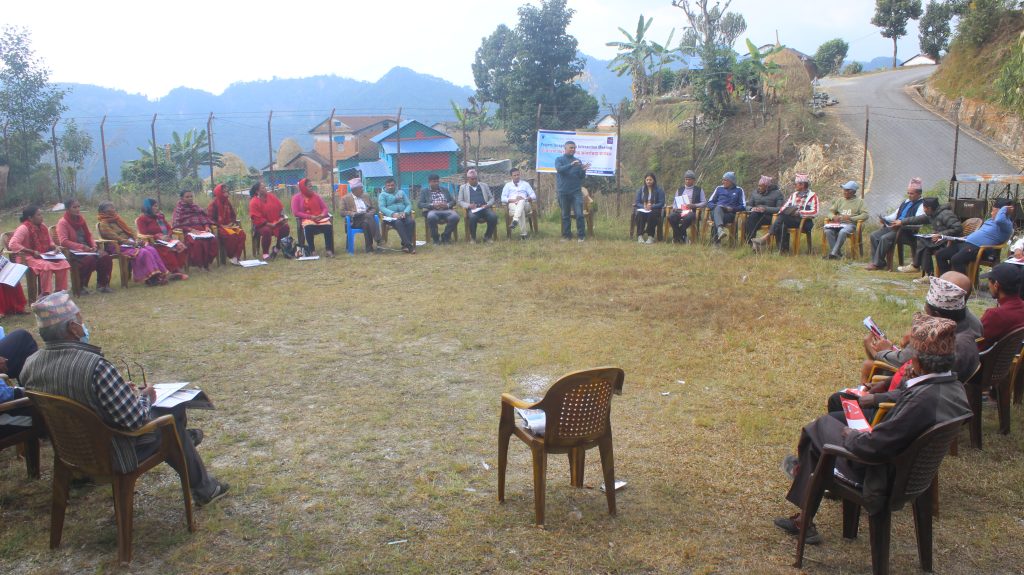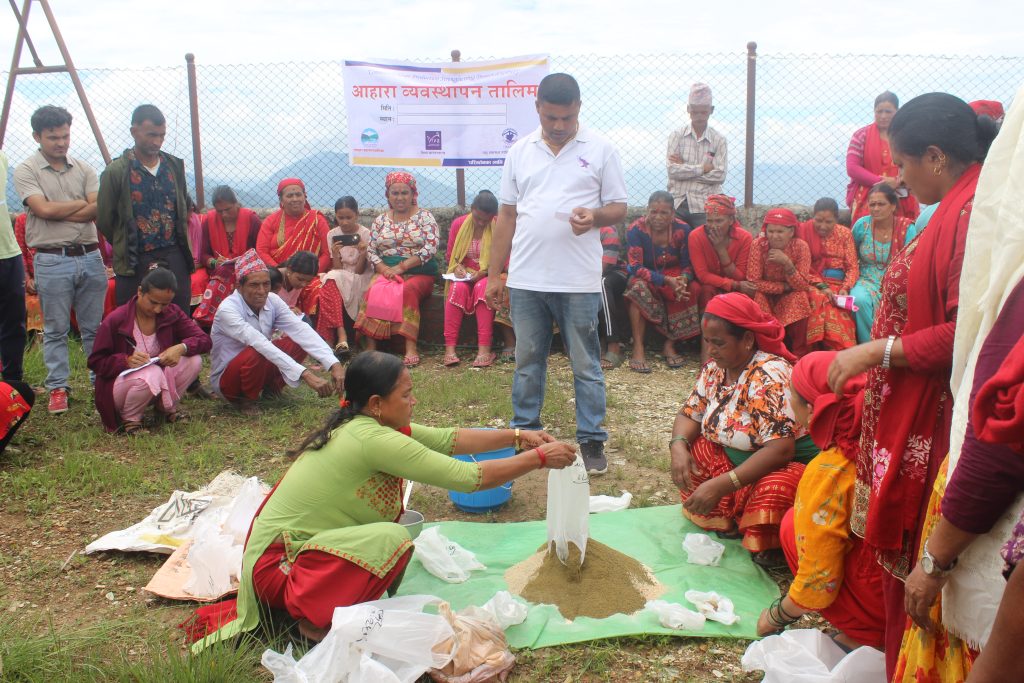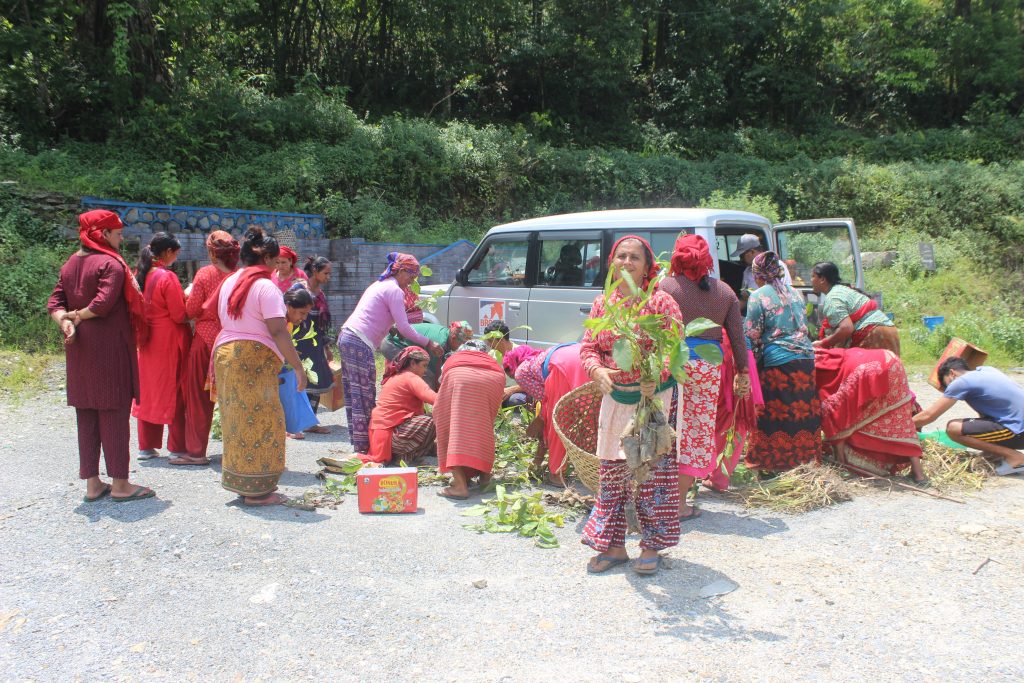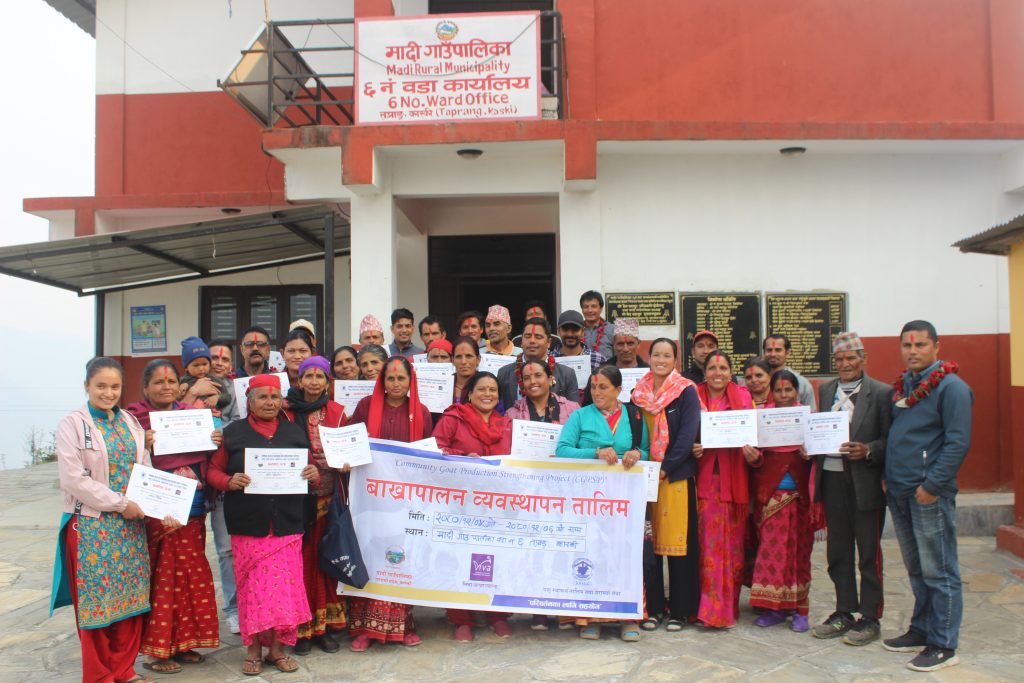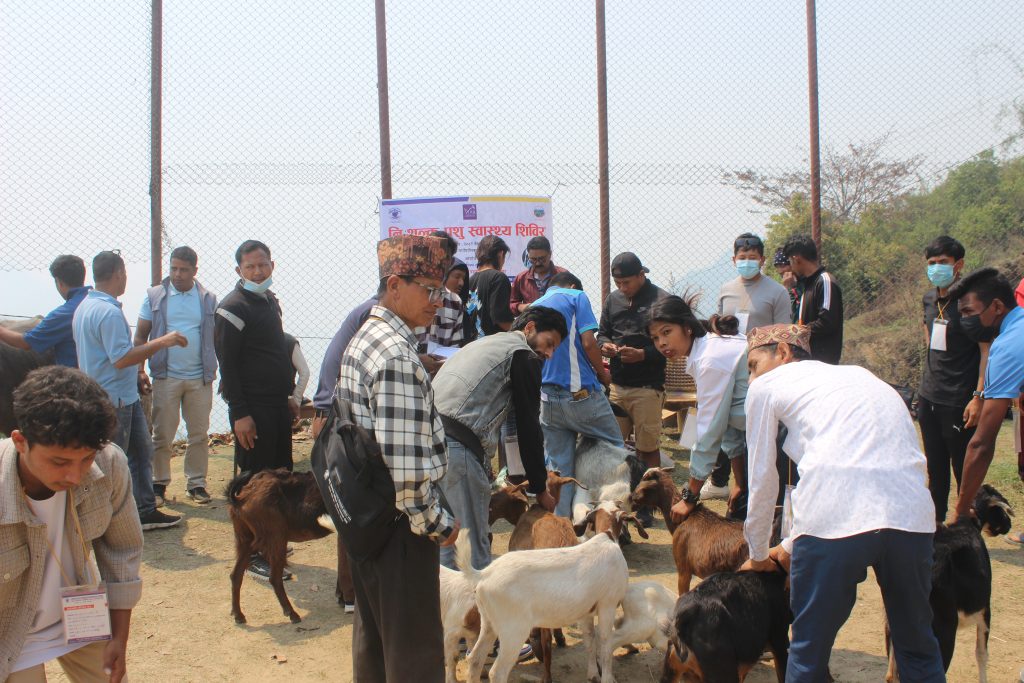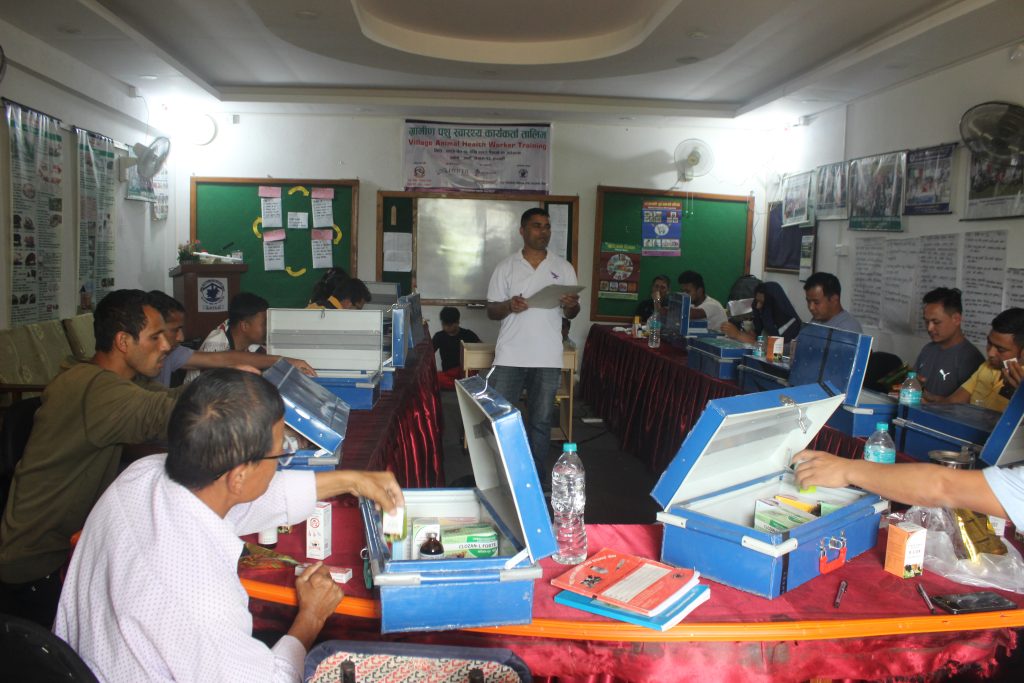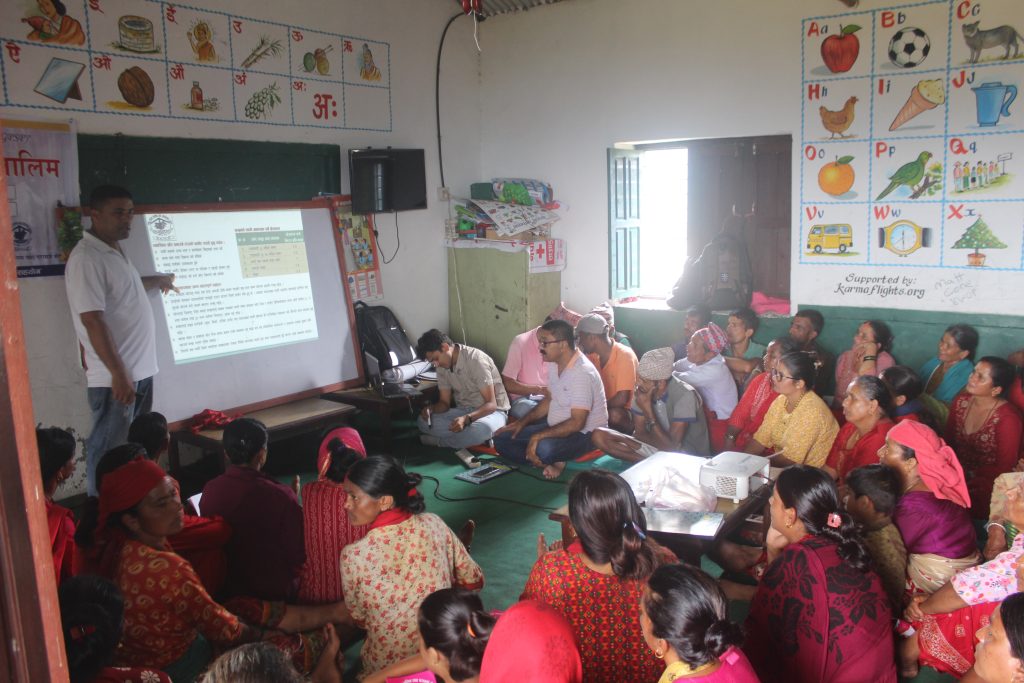Supporting Agency: Volunteers in Irish Veterinary Assistance (VIVA), Ireland
Implementing Partners: Animal Health Training and Consultancy Service (AHTCS), Nepal
Duration: 2024-2027
Theme: Livelihood Promotion through Strengthening of Goat Value Chain
Sub Sectors: Community Engagement, Livelihood Promotion, Training and Extension, Marketing, Husbandry Practices, Breed Improvement, Women’s participation, Collaboration and Coordination
Catchment areas: Kaski, Gandaki Province, Nepal
Project Description
Community Goat Production Strengthening Project (CGPSP)
Community Goat Production Strengthening Project (CGPSP), a joint initiative between Animal Health Training and Consultancy Service (AHTCS) Nepal and Volunteers in Irish Veterinary Assistance (VIVA) Ireland, holds the potential to considerably improve the socioeconomic status of goat farmers in the target areas by addressing the prevalent challenges and fostering the sustainable practices through holistic approach. The partnership boosts a rich history of more than a decade with a track record of successful joint ventures ensuring positive sustainable impact on animal health and management practices.
AHTCS officially launched the project in December 2023. The project captures the goat rearing communities of Pokhara-16, Armalaa and Maadi Rural Municipality and aims to extend direct coverage to 120 households throughout its three year’s long strategic timeframe. The partnership seeks to enhance the quality of life and ensure livelihood-resilient communities through the promotion of commercial goat farming value chain. To ensure the effective implementation and long-lasting impact on the communities, the project is tailored accordingly to meet the immediate and long-term needs of the communities. The following components constitutes the core of the project’s major strategic interventions:
- Community Engagement/Empowerment
- Promotion of Good Husbandry Practices
- Local Capacity Building
- Promotion and improvement of indigenous resources
- Networking and market extension
- Coordination and collaboration
Goal
Improve the socio-economic status of subsistence farmers in project areas through improved farming practices, and direct access to the market.
Project command areas’ demography/ Community profile
The project is endorsed among the goat owning communities Maadi Rural Municipality, Kaski, Gandaki province, Nepal. 107 goat keeping households spread across Ward no. 03, 04 and 06 of Maadi Rural Municipality, Kaski are expected to directly benefit from the project interventions. The target rural municipality is situated in the hilly belt of Nepal ranging from 500-1500 m altitude from sea level, annual precipitation of 3373 mm and varying temperature of 0-30ºC. Pokhara, arguably the tourism capital of Nepal and one of the megamarket/ biggest consumers of agricultural products of this region, lies about 36 KM from the target communities.
Maadi rural municipality has 4314 households (avg. family size: 5.98) and a total population of 25779 with male and female comprising 51.7% and 48.3% respectively. Agriculture remains the major source of income generation with 64.15% household engagement, followed by foreign employment (14.26%), government services (6.48%), construction/daily wager (5.26%), business/trade/petty shop (4.17%) and others. The area is predominantly inhabited by Janajati (44.21%), followed by Brahmin (36.57%) and Dalit (19.22%). Similarly, 54.7% of total land is covered by forest, 11.47% of the land is conducive for agricultural production, while grazing land tallies 9.67%.
The livestock sector forms an indispensable component of rural livelihood and contributes to the major share of local revenue. Among the livestock species, goat accounts for more than 20% of the total livestock population with 12933 head counts and an average of nearly 3 goat heads per household. Goats are primarily reared for meat purposes with an annual meat production of 13189 Kgs. The most prominent goat breeds are Khari, a native/indigenous breed, as well as Khari hybrid (Khari*Boer), Khari Hybrid (Kahri*Jamunapari). The majority of goat farming practice is still conventional and subsistent with only a few chunks of farmers opting for commercialization of the enterprise.
Major problems facing the communities:
- Housing management: Majority of the farmers have very little land holding thus compelling the farmers to opt for a conventional and compromised shed without appropriate provision of adequate space, ventilation, feeding and drinking facilities, drainage. The makeshift sheds are small establishments connected to the house.
- Inadequate nutritional status: Amid gap in knowledge in part of farmers as well as financial shortcomings, animals are deprived of balanced nutrition culminating in decreased productivity and leaving them vulnerable to various diseases and non-optimal health conditions.
- Lack of resources/Limited resources among the farming communities: Farmers often lack financial, physical as well as human capital required to ensure the practical implementation of the acquired knowledge and skills. For instance, farmers are aware about the housing managements however, lack of land at their disposal limits them from providing optimum housing facilities for their animals. Human needs are obviously prioritized over the animal’s and the limited resources that they have are channelized accordingly thus compromising animal’s needs.
- Conventional subsistence farming system
- No rigid breed improvement strategy: Khari, an indigenous breed, is the most prominent goat breed in these communities as well as all over the hilly areas of Nepal in general. Despite its excellent adaptability to the hilly environment, the pure Khari breed has lower production potential as compared to the other crossbred goats such as Khari*Boer, Khari*Jamunapari, Khari*Beetal, etc. Different studies have demonstrated considerable increment in productivity and higher economic return from such hybrids compared to the pure Khari breeds. However, barring a few champion farmers, most of the communities rely upon the traditional breeding methods; using the household buck or neighbor’s buck or from nearby village at most, thus persisting with the conventional inbreeding practice. To summarize, prevalent inbreeding practices, non-existent selection and crossbreeding practices are the major constraints preventing breed improvement (breed upgrading) in catchment areas.
- Scarcity of green fodder: Although the project command areas contain large dense forestland, farmers often face seasonal shortage of green fodder/forage for the animals, especially during the dry winter season. This scarcity either leads to inadequate nutritional status or shifting to more expensive concentrate feed and supplements to fulfill the nutritional requirements of the animals thus incurring additional feeding cost.
- Goat marketing channel: Existing goat market system is heavily reliant upon local community market and middlemen led network. The current goat rearing pattern is mostly subsistence with limited scale of production, a large chunk of which is consumed within the local communities and markets. Besides, middleman collects goats from the farmers/villages and ship them to the Pokhara where they are traded with the retailers. Within the second channel, a major share of the benefit goes to the middleman instead of the farmers. This is illustrated by the fact that the cost of per kg of goat meat is NRs 900 in local villages whereas it’s traded for NRs 1350 per kg in regional markets such as Pokhara.
- Price variability and no scientific trading structure: Live goats are traded on animal head basis and assumption based on observation rather than actual bodyweight and no scientific pricing system exists. Most of the time, the animals are significantly undervalued leading to unfair return to the farmers.
- Lack of technical expertise: Local communities, local service providers, animal healthcare providers, concerned institutions as well as local government vet units often lack technical expertise regarding quality veterinary treatment and consultation services, innovative approaches to address the prevalent issues (housing, nutrition, breed improvement, disease prevention, etc.), avenues for commercialization of the enterprise and scientific well-structured marketing chain.
- Unavailability of services and equipment at local market: Essential medicines, animal feeds and supplements, fodder seeds, fertilizers as well as other equipment are not readily available in the local market and needs to be imported from distant market (Pokhara) thus preventing communities for receiving timely services as well as forcing them to pay higher prices.
- Animal Insurance: Farmers are unaware and thus missing out on the Nepal Government’s subsidy-based Livestock Insurance Scheme which covers the financial risks associated with the goat farming enterprise and helps them to be more resilient during the crisis.
- Ineffective Government Policies and schemes: Government’s plans and policies are either ineffective/deviated from actual needs or utterly complicated and tiring and ultimately fail to reach the actual beneficiaries/farmers. It’s further complicated by the unjust political influence and often, the government services/benefits are hijacked by the political cadres.
- Health related problems: Contagious diseases like PPR, FMD as well as respiratory problems, digestive diseases, plant poisoning/toxicity, internal parasites, ectoparasitic infestation were found to be the major health related problems among the goats of the catchment communities. Lack of vet clinics, agrovets and limited vet technicians within/nearby the communities deprive animals from receiving prompt medical attention and endure prolonged suffering and worsening health condition.
- Human wildlife conflict: Unchecked deforestation, unregulated exploitation of the ecosystem, destruction of habitat and food sources compounded by the tangible effects of climate change have forced wild animals to move out of their perch and intrude the nearby communities particularly in search of food. The most encountered ones are a troop of monkeys, tigers, leopards, mongooses, etc. These wanderers often consume and destroy agricultural commodities, fruits and occasionally prey on domestic animals as well as disrupt human habitats. Sporadic incidents of human loss are also recorded every now and then.
Key Interventions and Approaches
- Establishment and Strengthening Farmer’s Group
To foster collective action among farmers for better learning and sharing experience, peer motivation and encouragement to seek and extend good practices, increase access to multiple livelihood opportunities, become more resilient to the impeding threats and risks as well as ensure meaningful recognition and inclusion in the plans and policies, AHTCS focuses on formation and strengthening of Farmer’s group. It also promotes saving and credit mobilization schemes within the groups and connects them with local financial institutions like cooperatives, microfinance and banks to support communities in financial hardships as well as livelihood generation. Similarly, local capacity building, resource mobilization, and community ownership foster sustainable development.
- Promotion of Good Husbandry Practices
To ensure the optimum health and productivity through improved management practices, the project interventions prioritize training farmers on proper feeding, housing, and healthcare for livestock, promotion of biosecurity measures to prevent disease outbreaks. introduction and adoption of vaccination and deworming practices, extension of effective breeding practices as well as systematic record-keeping system.
- Upgrading of Indigenous Goat Breeds
Barring few champion farmers, most of the communities rely upon the traditional breeding methods; using the household buck or neighbor’s buck or from nearby village at most, thus persisting with the conventional inbreeding practice. To summarize, prevalent inbreeding practices, non-existent selection and crossbreeding practices are the major constraints preventing breed improvement (breed upgrading) in catchment areas.
Enhancing the production potential through genetic improvement of local goat breeds for better meat and milk production. Key operational interventions include orientation to farmers on selection of superior indigenous goats and breeding methods, promotion of crossbreeding with high-yielding exotic breeds, establishment of goat resource center as well as distribution of improved breeding bucks to the Farmers group.
- Strengthening Marketing Channels
Existing goat market system is heavily reliant upon local community market and middlemen led network. Middleman collects goats from the farmers/villages and ship them to the Pokhara where they are traded with the retailers. Within the second channel, a major share of the benefit goes to the middleman instead of the farmers. Similarly, Live goats are traded on animal head basis and assumption based on observation rather than actual bodyweight and no scientific pricing system exists. Most of the time, the animals are significantly undervalued leading to unfair return to the farmers. AHTCS invests in identification and development of local and regional markets, facilitation of direct linkages with buyers and processors and sensitizing farmers to ensure a scientific uniform pricing system across the communities.
- Introduction and Promotion of Livestock Insurance Scheme
Livestock insurance education among the conventional farmers is far and limited and thus is devoid of the government’s livestock insurance benefits. Building the resilient livelihood and to mitigate the financial risks associated with livestock farming, animal insurance remains the vital and pragmatic measure. To ensure livestock insurance literacy among communities, initiatives are directed to orientation of farmers on process and perks of insurance, networking and linkage of communities with the insurance companies as well as guidance through the various procedures including initial registration, terms and conditions, premium rates as well as insurance claim process.
- Endorsement of Goat Farming Based Livelihood Generation
Goat meat is widely accepted by almost every community in Nepal and our farming system is yet to meet the demand, it provides great scope for investment and scaling up of the goat enterprise. It offers a viable and sustainable livelihood opportunity and could help mitigate the increasing trend of youth foreign employment. Goat farming training, linking communities with financial institution to provide capital support, orienting and connecting with government provisioned subsidies and schemes, networking with market channel as well as in kind support (animals, infrastructure development as well as equipment) are key to realizing the project outcomes and ensure betterment of the livelihood of rural communities.
- Strengthening Local Animal Healthcare System:
Sustainable animal healthcare system ensuring accessible and quality veterinary services through production and mobilization of community level technical workforce (VAHW) remains a major component of the project. Similarly, mentoring and guidance of trained VAHWs, timely refresher training and medicine and equipment support aids to effective service delivery. Besides, regular animal health camps, vaccination campaigns, evidence based educational session as well as capacity building of farmers to undertake first aid and preventive measures strengthens the cause and fosters sustainable animal healthcare network.
- Coordination and Collaboration:
Entire project interventions are designed in a way that requires astute coordination and collaboration right from the planning to the execution phase. Local government bodies, local institutions, communities, local service providers as well as other likeminded development agencies are the crucial partners and collaborative effort is warranted to optimize the resource mobilization and their effectiveness and realize mutual growth while ensuring the success of the project.

